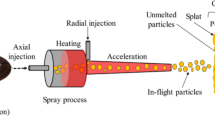Abstract
Residual stress buildup in thick thermal spray coatings is a property of concern. The adhesion of these coatings to the substrate is influenced by residual stresses that are generated during the coating deposition process. In the HVOF spray process, significant peening stresses are generated during the impact of semimolten particles on the substrate. The combination of these peening stresses together with quenching and thermal mismatch stresses that arise after deposition can be of significant importance. Both numerical method, i.e., Finite Element Method (FEM), and experimental methods, i.e., the Modified Layer Removal Method (MLRM) and Neutron Diffraction, to calculate peening and quenching stresses have been utilized in this work. The investigation was performed on thick Inconel 718 coatings on Inconel 718 substrates. Combined, these numerical and experimental techniques yield a deeper understanding of residual stress formation in the HVOF process and thus a tool for process optimization. The relationship between the stress state and deposit/substrate thickness ratio is given particular interest.









Similar content being viewed by others
References
S. Sampath, Y.Y. Jiang, J. Matejicek, L. Prchlik, A. Kulkarni and A. Vaidya, 2004 Mater. Sci. Eng., 364(1–2), 216–231.
J. Matejicek, S. Sampath, D. Gilmore and R. Neiser, 2003 Acta. Mater., 51, 873–885.
C.R.C. Limaa, J. Ninb, J.M. Guilemany, 2006 Evaluation of residual stresses of thermal barrier coatings, Surf. Coat. Technol. 200, 5963–5972.
M. Ohring, Materials Science of Thin Films, Deposition and Structures, Academic Press, 2002.
T.W. Clyne, and S.C. Gill, 1996 Residual Stresses in Thermal Spray Coatings and Their Effect on Interfacial Adhesion: a Review of Recent Work. J. Therm. Spray Tech., 4, 401–409.
R. Moltz, A. Valarezo, and S. Sampath, Comparison of Coating Stresses Produced by High Velocity Liquid/Gas Fuel and Triplex 200 Plasma Processes Using In-Situ Coating Stress Measurement, Proceedings of the ITSC 2008, Maastricht, Netherlands, 2008, p 473-478
C. Godoy, E.A. Souza, M.M. Lima, and J.C.A. Batista, 2002 Correlation between residual stresses and adhesion of plasma sprayed coatings: effects of a post-annealing treatment. Thin Solid Films, 420–421, 438–445.
S.C. Gill, and T.W. Clyne, 1994 Investigation of residual stress generation during thermal spraying by continuous curvature measurements. Thin Solid Films, 250, 172–180.
P. Araujo, D. Chicot, M. Staia, and J. Lesage, 2005 Residual Stresses and Adhesion of Thermal Spray Coatings. Surf. Eng., 21, 35–40.
P.J. Withers, and H.K.D. Bhadeshia, 2001 Residual stress – Measurement techniques. Mater. Sci. Technol., 17, 355–365.
F.A. Kandil, J.D. Lord, A.T Fry, and P.V. Grant, A Review of Residual Stress Measurement Methods, NPL Materials Centre, report MATC(A)04, 2000.
ASM International-TSS. Accepted Practice Mechanical Properties # 1-AP MP001-02 Modified layer Removal Method for Evaluating Residual Stresses in Thermal Spray Coatings, ASM-TSS, Materials Park, OH, USA, 2002, p 25
D.J. Greving, E.F. Rybicki, and J.R. Shadley, 1994 Through-thickness residual stress evaluation for several industrial thermal spray coatings using a Modified Layer-Removal Method. J. Therm. Spray Tech., 3(4), 379–388.
J. Pina, A. Dias, J.I. Lebrun, 2003 Study by X-Ray diffraction and mechanical analysis of the residual stress generation during thermal spraying. Mat. Sc. and Eng. A347, 21–31.
T.C. Totemeier, R.N. Wright, W.D. Swank, 2004 Residual Stresses in High-Velocity Oxy-Fuel Metallic Coatings. Metallurgical and materials Transactions, 35A, 1807–1814.
R.T.R. McGrann, E.F. Rybicki, and J.R Shadley, Applications and Theory of the Modified Layer Removal Method, Proceedings of the Fifth ICRS, Linköping, Sweden, June 16-18, 1997.
S.A. Meguid, G. Shagal, J.C. Stranart, 1999 Finite Element Modelling of Shot-Peening Residual Stresses. Mat. Proc. Tech., 92–93:401–404.
K. Yokoyama, M. Watanabe, S. Kuroda, Y. Gotoh, T. Schmidt, F. Gärtner, 2006 Simulation of Solid Particle Impact Behavior for Spray Processes. Mat. Trans., 47(7), 1697–1702.
P. Bansal, P.H. Shipway, S.B. Leen, Acta Materialia, 2007, 55, 5089-5101.
Internal Report, Volvo Aero Corporation
C. Lyphout, P. Nylén, and J.Wigren, Characterization of Adhesion Strength and Residual Stress of HVOF sprayed Inconel 718, Proceedings of the ITSC 2007, Beijing, China, 2007, p 588-593
Q. Fan and L. Wang, Modelling of Temperature and Residual Stress Fields, Proceedings of the ITSC 2005, Basel, Switzerland, 2005, p 275-279
T. Hong et al., A Numerical Simulation to Relate the Shot Peening Parameters to the Induced Residual Stresses, Eng. Fail. Anal., 2008, 15, p 1097-1110
Acknowledgments
The authors acknowledge the financial support of the VINNOVA (Swedish Governmental Agency for Innovation Systems) funded NFFP project and the technical support of the Thermal Spray Department of Volvo Aero Corporation (Trollhättan, Sweden). The research project has been supported by the EC under the 6th Framework Programme through the Key Action: Strengthening the European Research Area, Research Infrastructures. Contract no.: RII3-CT-2003-505925 (NMI3). The authors would like to thank Dr. R. Wympory and Dr. D.J. Hughes for their respective collaboration to carry out Neutron Diffraction measurement at the Hahn-Meitner Institute (Berlin) and at the Laue-Langevin Institute (Grenoble). Particular acknowledgments are addressed to Kjell Niklasson of University West (Trollhättan) for supervision in the FEA simulations.
Author information
Authors and Affiliations
Corresponding author
Additional information
An erratum to this article can be found at http://dx.doi.org/10.1007/s11666-008-9289-7
Rights and permissions
About this article
Cite this article
Lyphout, C., Nylén, P., Manescu, A. et al. Residual Stresses Distribution through Thick HVOF Sprayed Inconel 718 Coatings. J Therm Spray Tech 17, 915–923 (2008). https://doi.org/10.1007/s11666-008-9242-9
Received:
Revised:
Accepted:
Published:
Issue Date:
DOI: https://doi.org/10.1007/s11666-008-9242-9




